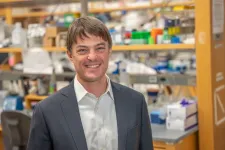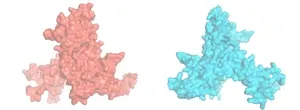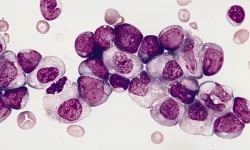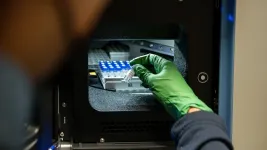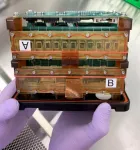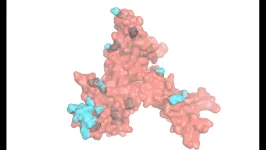(Press-News.org) A study published in Immunity by physician-scientist Read Pukkila-Worley, MD, and MD/PhD students Nicholas D. Peterson and Samantha Y. Tse describes a new manner of detecting microbial infection that intercepts pathogen-derived signals of growth to assess the relative threat of virulent bacteria. A nuclear hormone receptor in the nematode C. elegans senses a toxic metabolite produced by the bacterial pathogen Pseudomonas aeruginosa to activate innate immunity. These data reveal an ancient strategy that informs the origins of pathogen detection and may be among the most primordial forms of immune sensing in animals.
“Our research adds to our understanding of how hosts differentiate between beneficial and harmful bacteria, which teaches us something important about how our immune systems evolved,” said Dr. Pukkila-Worley, associate professor of medicine.
Distinguishing potentially harmful pathogens from benign microorganisms is one of the primary functions of the innate immune system in all animals. This is particularly important for nematodes, such as C. elegans—the transparent microscopic worm often used as a model organism to study genetics and gene function—that consume bacteria as their food source.
Working with Pseudomonas aeruginosa, a bacteria that commonly infects immune-compromised patients in the hospital and is increasingly resistant to standard antibiotic treatments, Pukkila-Worley and colleagues performed a series of genetic screens with mutant bacteria, one-by-one, to see if any impacted the innate immune system response in C. elegans.
They found that bacteria that cannot produce a specific phenazine metabolite were able to avoid detection by the innate immune system, suggesting that the bacterial phenazine metabolite was sensed to activate innate immunity.
“This result was intriguing because P. aeruginosa use phenazines for growth and virulence. Thus, the innate immune system can intercept signals produced by bacteria in order to identify bacteria that have grown to dangerous levels and are poised to cause disease,” said Pukkila-Worley.
Researchers in the Pukkila-Worley lab designed a second experiment to identify the sensor in the host that detects these phenazine metabolites. They discovered that a specialized type of transcription factor, a nuclear hormone receptor, binds the phenazine metabolite and directly activates anti-pathogen defenses.
“One of the striking things about our results is that C. elegans senses this bacterial metabolite to detect an individual bacterial pathogen in a remarkably specific manner from among its bacterial food,”said Peterson, an MD/PhD student in the Pukkila-Worley lab.
In humans, pattern-recognition systems in the intestine involving Toll-like receptors scan the physical structure of different bacteria to sense the presence of infectious microorganisms. Nematodes lost pattern-recognition receptors in evolution. Pukkila-Worley and colleagues show that nematodes use nuclear hormone receptors to detect specific pathogen-derived metabolites to activate innate immunity, which represents a new type of pattern-recognition.
Since C. elegans have 274 nuclear hormone receptors, it’s possible that the nematode genome contains dozens of these metabolite recognition systems. Nuclear hormone receptors are also found in most animals, including humans, suggesting that similar metabolite detection systems might exist in other organisms.
“It’s remarkable that C. elegans evolved mechanisms to differentiate good and bad bacteria even without canonical receptors for pathogen detection. This further supports the importance of understanding how our immune system evolved over time to deepen our understanding of host-microbiome interactions,” said Tse, an MD/PhD student in the Pukkila-Worley lab.
END
UMass Chan investigators identify new pattern recognition system that monitors disease-causing bacteria in C. elegans
A nuclear hormone receptor intercepts pathogen-derived signals of growth and virulence, revealing an evolutionarily ancient strategy of immune sensing
2023-03-07
ELSE PRESS RELEASES FROM THIS DATE:
Blood test identifies acute myeloid leukemia patients at greater risk for relapse after bone marrow transplant
2023-03-07
Blood test identifies acute myeloid leukemia patients at greater risk for relapse after bone marrow transplant
A small portion of adults in remission from a deadly blood cancer had persisting mutations that were detected, which predicted their risk of death from having the cancer return
Researchers at the National Institutes of Health show the benefits of screening adult patients in remission from acute myeloid leukemia (AML) for residual disease before receiving a bone marrow transplant. The findings, published in JAMA, support ongoing research aimed ...
Whistleblowers losing faith in media impact
2023-03-07
The whistleblowers who once trusted journalism are losing faith in the institution.
A new study from the University of Georgia found that many whistleblowers who reached out to journalists in the past no longer believe media has the same ability to motivate change, and they feel let down by a system they once trusted.
“If you don’t believe that an outlet or journalist can carry you across the finish line—meaning can affect change, attract enough attention and attract the attention of the right people—then you’re losing faith,” said Karin Assmann, study lead and assistant professor in UGA’s Grady College of Journalism ...
STEP Demo pilot plant achieves supercritical CO2 fluid conditions
2023-03-07
SAN ANTONIO — March 7, 2023 —The Supercritical Transformational Electric Power (STEP) Demo pilot plant, a $155 million, 10-megawatt supercritical carbon dioxide (sCO2) test facility at Southwest Research Institute (SwRI) in San Antonio, developed in partnership with GTI Energy and GE Research and sponsored by the U.S. Department of Energy, has successfully achieved its first operation with CO2 at supercritical fluid conditions in its compressor section. This accomplishment represents significant progress toward ...
Splicing deregulation detected and targeted in type of childhood leukemia
2023-03-07
Pediatric acute myeloid leukemia or pAML is a childhood blood cancer, one that has proved confounding to clinicians and researchers, with a high relapse rate and relatively few identified genetic mutations (compared to the adult version) that might explain its cause.
In a new study, published in the March 7, 2023 issue of Cell Reports, an international team led by scientists and physicians at University of California San Diego School of Medicine deployed an array of analytical and gene-splicing tools to parse more deeply the mysteries of mutation in pAML.
“Compared to adult AML, pediatric AML is associated with relatively ...
Synchronizing to a beat predicts how well you get ‘in sync’ with others
2023-03-07
How well you synchronize to a simple beat predicts how well you synchronize with another mind, according to a new Dartmouth study published in Scientific Reports.
Previous work has demonstrated that the pupil dilation patterns of speakers and listeners synchronize spontaneously, illustrating shared attention. The team set out to understand how the tendency to synchronize in this way may vary at the individual level and generalize across contexts, as it has been widely debated whether one form of synchrony bears any relationship to another.
“We were ...
How high altitude changes your body’s metabolism
2023-03-07
SAN FRANCISCO, CA—March 7, 2023—Compared to those of us who live at sea level, the 2 million people worldwide who live above 4,500 meters (or 14,764 feet) of elevation—about the height of Mount Rainier, Mount Whitney, and many Colorado and Alaska peaks—have lower rates of metabolic diseases such as diabetes, coronary artery disease, hypercholesterolemia, and obesity.
Now, researchers at Gladstone Institutes have shed light on this phenomenon. They showed how chronically low oxygen levels, such as those experienced at high elevation, rewire how mice burn sugars ...
Endocrine Society elects Newell-Price as 2024-2025 President
2023-03-07
Endocrine Society members elected John Newell-Price, M.D., Ph.D., F.R.C.P., as its 2024-2025 President. He will serve as President-Elect for a year beginning in June 2023 before becoming President in June 2024.
Newell-Price is Professor of Endocrinology at the University of Sheffield in Sheffield, United Kingdom. He also is head of the endocrinology service at the Sheffield Teaching Hospitals NHS Foundation Trust and of the European Neuroendocrine Tumor Society at the hospital.
Newell-Price’s clinical expertise ...
Genetic and socioeconomic factors interact to affect risk of type 2 diabetes and obesity
2023-03-07
BOSTON – New research led by investigators at Massachusetts General Hospital (MGH), a founding member of Mass General Brigham (MGB), indicates that socioeconomic and genetic factors likely interact in an additive way to affect people’s risks of developing obesity and type 2 diabetes. The findings, which are published in Diabetes Care, suggest that interventions to improve socioeconomic deprivation may decrease metabolic diseases at the individual and community levels, especially among people with concomitant high genetic risk.
Genetic and socioeconomic factors—one intrinsic and unmodifiable and ...
Heart tissue heads to space to aid research on aging and impact of long spaceflights
2023-03-07
Note: Johns Hopkins Medicine researchers Deok-Ho Kim and Devin Mair will participate in a NASA teleconference for journalists on Tuesday, March 14, at 11 a.m. ET.
Johns Hopkins Medicine researchers are collaborating with NASA to send human heart “tissue-on-a-chip” specimens into space as early as March. The project is designed to monitor the tissue for changes in heart muscle cells’ mitochondria (their power supply) and ability to contract in low-gravity conditions.
The tissue samples will ...
Heart toggles between maintenance and energy-boost mode using ribosomes
2023-03-07
Researchers at the Centre for Genomic Regulation (CRG) in Barcelona have discovered a mechanism involving ribosomes which helps the heart toggle between a ‘regular maintenance mode’ for day-to-day function and an ‘energy-boost mode’ which aids recovery for high-demand situations including heart attacks. The findings are published in a ‘Breakthrough Article’ in the journal Nucleic Acids Research, a distinction awarded to studies that answer long-standing questions in the field.
Ribosomes are the molecular factories that manufacture proteins in all living cells. Historically, they have been ...
LAST 30 PRESS RELEASES:
SwRI upgrades nuclear magnetic resonance laboratory for pharmaceutical R&D
House sparrows in northern Norway can help us save other endangered animals
Crohn's & Colitis Foundation survey reveals more than 1/3 of young adults with IBD face step therapy insurance barriers
Tethered UAV autonomous knotting on environmental structures for transport
Decentralized social media platforms unlock authentic consumer feedback
American Pediatric Society announces Vanderbilt University School of Medicine as host institution for APS Howland Visiting Professor Program
Scientists discover first method to safely back up quantum information
A role for orange pigments in birds and human redheads
Pathways to net-zero greenhouse gas emissions for Southeast Asia
A JBNU–KIMS collaborative study on a cost-effective alloy matches superalloys for power plants and energy infrastructure
New study overturns long-held model of how plants coordinate immune responses.
New AI model predicts disease risk while you sleep
Scientists discover molecular ‘reshuffle’ and crack an 80-year-old conundrum
How stressors during pregnancy impact the developing fetal brain
Electrons lag behind the nucleus
From fungi to brain cells: one scientist's winding path reveals how epigenomics shapes neural destiny
Schizophrenia and osteoporosis share 195 genetic loci, highlighting unexpected biological bridges between brain and bone
Schizophrenia-linked genetic variant renders key brain receptor completely unresponsive to both natural and therapeutic compounds
Innovative review reveals overlooked complexity in cellular energy sensor's dual roles in Alzheimer's disease
Autism research reframed: Why heterogeneity is the data, not the noise
Brazil's genetic treasure trove: supercentenarians reveal secrets of extreme human longevity
The (metabolic) cost of life
CFRI special issue call for papers: New Frontiers in Sustainable Finance
HKU Engineering scholar demonstrates the smallest all-printed infrared photodetectors to date
Precision empowerment for brain "eavesdropping": CAS team develops triple-electrode integrated functional electrode for simultaneous monitoring of neural signals and chemical transmitters during sleep
Single-capillary endothelial dysfunction resolved by optoacoustic mesoscopy
HKU three research projects named among ‘Top 10 Innovation & Technology News in Hong Kong 2025’ showcasing excellence in research and technology transfer
NLRSeek: A reannotation-based pipeline for mining missing NLR genes in sequenced genomes
A strand and whole genome duplication–aware collinear gene identification tool
Light storage in light cages: A revolutionary approach to on-chip quantum memories
[Press-News.org] UMass Chan investigators identify new pattern recognition system that monitors disease-causing bacteria in C. elegansA nuclear hormone receptor intercepts pathogen-derived signals of growth and virulence, revealing an evolutionarily ancient strategy of immune sensing
